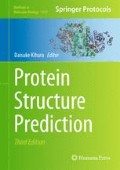Abstract
Protein–protein interactions lie at the heart of most cellular processes. Determining their high-resolution structures by experimental methods is a nontrivial task, which is why complementary computational approaches have been developed over the years. To gain structural and dynamical insight on an atomic scale in these interactions, computational modeling must often be complemented by low-resolution experimental information. For this purpose, we developed the user-friendly HADDOCK webserver, the interface to our biomolecular docking program, which can make use of a variety of low-resolution data to drive the docking process. In this chapter, we explain the use of the HADDOCK webserver based on the real-life Lys48-linked di-ubiquitin case, which led to the 2BGF PDB model. We demonstrate the use of chemical shift perturbation data in combination with residual dipolar couplings and further highlight a few other cases where our software was successfully used. The HADDOCK webserver is available to the science community for free at haddock.science.uu.nl/services/HADDOCK.
Access this chapter
Tax calculation will be finalised at checkout
Purchases are for personal use only
References
Stumpf MPH, Thorne T, de Silva E et al (2008) Estimating the size of the human interactome. Proc Natl Acad Sci USA 105: 6959–6964
Moreira IS, Fernandes PA, Ramos MJ (2010) Protein-protein docking dealing with the unknown. J Comput Chem 31:317–342
Dominguez C, Boelens R, Bonvin AMJJ (2003) HADDOCK: a protein-protein docking approach based on biochemical or biophysical information. J Am Chem Soc 125: 1731–1737
de Vries SJ, van Dijk ADJ, Krzeminski M et al (2007) HADDOCK versus HADDOCK: new features and performance of HADDOCK2.0 on the CAPRI targets. Proteins 69:726–733
van Dijk ADJ, Fushman D, Bonvin AMJJ (2005) Various strategies of using residual dipolar couplings in NMR-driven protein docking: application to Lys48-linked di-ubiquitin and validation against 15N-relaxation data. Proteins 60:367–381
van Dijk ADJ, Kaptein R, Boelens R et al (2006) Combining NMR relaxation with chemical shift perturbation data to drive protein-protein docking. J Biomol NMR 34: 237–244
Schmitz C, Bonvin AMJJ (2011) Protein-protein HADDocking using exclusively pseudocontact shifts. J Biomol NMR 50:263–266
Karaca E, Bonvin AMJJ (2013) On the usefulness of ion-mobility mass spectrometry and SAXS data in scoring docking decoys. Acta Crystallogr D Biol Crystallogr 69:683–694
van Dijk ADJ, Bonvin AMJJ (2006) Solvated docking: introducing water into the modelling of biomolecular complexes. Bioinformatics 22: 2340–2347
Janin J (2005) Assessing predictions of protein-protein interaction: the CAPRI experiment. Protein Sci 14:278–283
Lensink MF, Wodak SJ (2013) Docking, scoring and affinity prediction in CAPRI. Proteins 81:2082–2095
Varadan R, Walker O, Pickart C et al (2002) Structural properties of polyubiquitin chains in solution. J Mol Biol 324:637–647
Brünger AT, Adams PD, Clore GM et al (1998) Crystallography & NMR system: a new software suite for macromolecular structure determination. Acta Crystallogr D Biol Crystallogr 54:905–921
Brünger AT (2007) Version 1.2 of the crystallography and NMR system. Nat Protoc 2:2728–2733
de Vries SJ, van Dijk M, Bonvin AMJJ (2010) The HADDOCK web server for data-driven biomolecular docking. Nat Protoc 5:883–897
Wassenaar T, van Dijk ADJ, van Dijk M et al (2012) WeNMR: structural biology on the grid. J Grid Comp 10:743–767
de Vries SJ, Bonvin AMJJ (2011) CPORT: a consensus interface predictor and its performance in prediction-driven docking with HADDOCK. PLoS One 6:e17695
Rodrigues JPGLM, Melquiond ASJ, Karaca E et al (2013) Defining the limits of homology modelling in information-driven protein docking. Proteins 81:2119–2128
Krzeminski M, Loth K, Boelens R et al (2010) SAMPLEX: automatic mapping of perturbed and unperturbed regions of proteins and complexes. BMC Bioinformatics 11:51
Meiler J, Blomberg N, Nilges M et al (2000) A new approach for applying residual dipolar couplings as restraints in structure elucidation. J Biomol NMR 16:245–252
Rodrigues JPGLM, Trellet M, Schmitz C et al (2012) Clustering biomolecular complexes by residue contacts similarity. Proteins 80: 1810–1817
Schneider T, Kruse T, Wimmer R et al (2010) Plectasin, a fungal defensin, targets the bacterial cell wall precursor Lipid II. Science 328:1168–1172
Janin J (2013) The targets of CAPRI rounds 20-27. Proteins 81:2075–2081
Lensink MF, Méndez R, Wodak SJ (2007) Docking and scoring protein complexes: CAPRI 3rd edition. Proteins 69:704–718
Acknowledgments
Financial support from the Dutch Foundation for Scientific Research (NWO) (ECHO grant no. 711.011.009 and VICI grant no. 700.56.442) and the European Union (FP7 e-Infrastructure grant WeNMR no. 261572) is acknowledged.
Author information
Authors and Affiliations
Editor information
Editors and Affiliations
Rights and permissions
Copyright information
© 2014 Springer Science+Business Media New York
About this protocol
Cite this protocol
van Zundert, G.C.P., Bonvin, A.M.J.J. (2014). Modeling Protein–Protein Complexes Using the HADDOCK Webserver “Modeling Protein Complexes with HADDOCK”. In: Kihara, D. (eds) Protein Structure Prediction. Methods in Molecular Biology, vol 1137. Humana Press, New York, NY. https://doi.org/10.1007/978-1-4939-0366-5_12
Download citation
DOI: https://doi.org/10.1007/978-1-4939-0366-5_12
Published:
Publisher Name: Humana Press, New York, NY
Print ISBN: 978-1-4939-0365-8
Online ISBN: 978-1-4939-0366-5
eBook Packages: Springer Protocols

